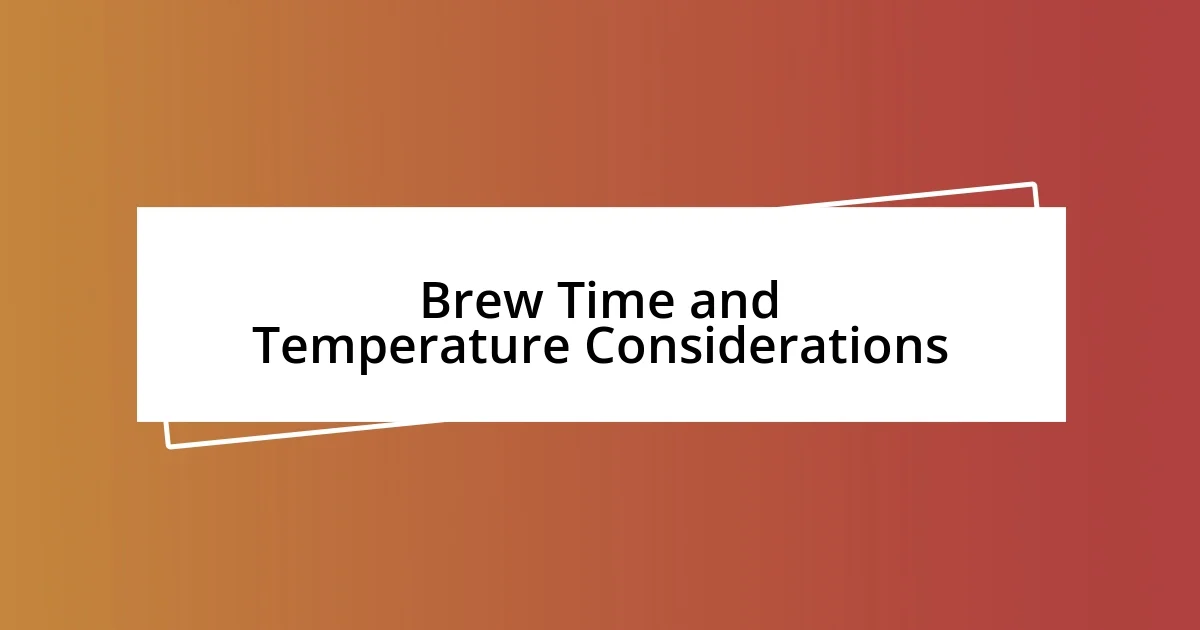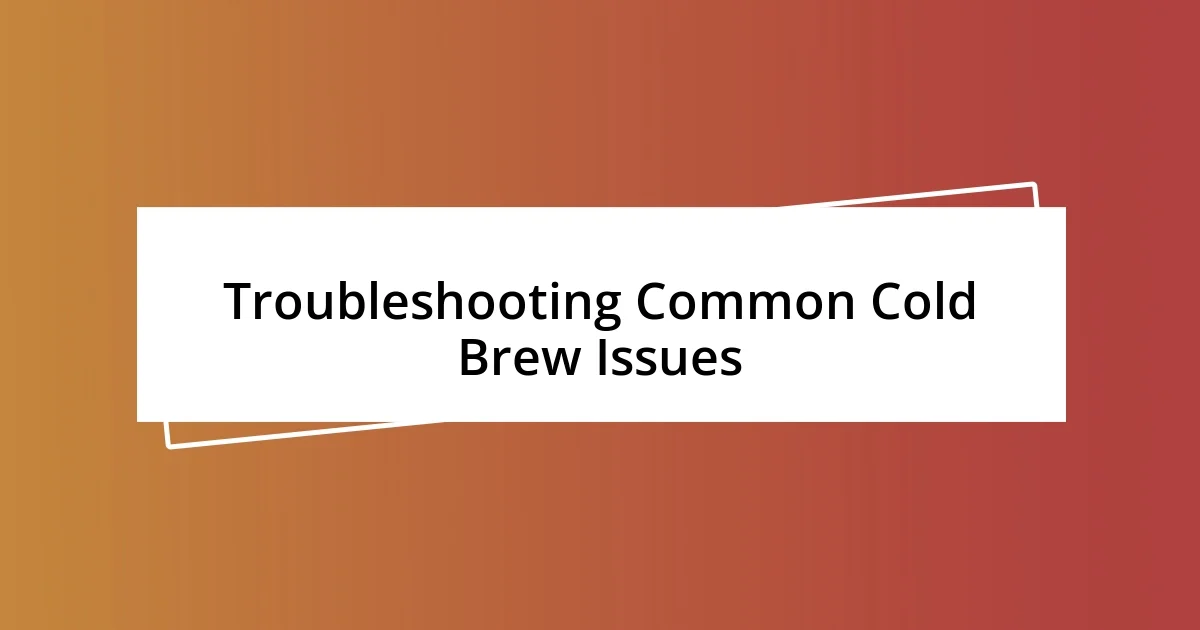Key takeaways:
- Cold brew coffee benefits from experimentation with coffee-to-water ratios, grind sizes, and steeping times to achieve the desired flavor and clarity.
- Using high-quality, freshly roasted beans and varying filtering techniques can significantly enhance the taste and presentation of cold brew.
- Flavor additives like vanilla, sea salt, and flavored syrups can elevate the cold brew experience by enhancing its natural sweetness and complexity.

Understanding Cold Brew Basics
Cold brew coffee, at its core, is a method where coarsely ground coffee is steeped in cold water for an extended period, usually 12 to 24 hours. When I first tried making it, I was amazed at how this simple process could result in a coffee that was not only smooth and rich but also less acidic than traditional brewing methods. Have you ever considered how brewing temperature can completely transform the flavors in your cup?
The beauty of cold brew lies in its versatility. You can experiment with different coffee beans and steeping times to find the perfect balance. I remember my first attempt with a single-origin Ethiopian coffee—its fruity undertones shone through, and it made me feel like a true coffee aficionado. Isn’t it exciting to think that with just a little patience, you can create something that rivals your favorite café?
Understanding the basics also means recognizing the importance of coffee-to-water ratios. Initially, I didn’t pay much attention to this, and my brews ranged from watery disasters to overly strong concoctions. After some trial and error, I found that a 1:4 ratio of coffee to water struck the right note for my taste. Don’t you think a little experimentation can lead to delightful surprises in your daily routine?

Choosing the Right Coffee Beans
Choosing the right coffee beans is an essential step in crafting a perfect cold brew. Personal experiences have taught me that opting for high-quality, freshly roasted beans can make a world of difference. The first time I used a blend from a local roastery, the rich, chocolatey notes transformed my cold brew into an indulgent treat, and I felt a sense of pride in my brewing skills. Have you ever tasted something that just elevated your coffee game?
When selecting beans, consider flavor profiles based on the origin. For instance, Central American beans tend to have a bright acidity, while beans from South America may offer a smoother finish. I vividly remember exploring different regions, and discovering how the earthy tones of a Colombian coffee contrasted beautifully with the bright citrus notes of an African bean. This diversity allows for endless experimentation—what’s not to love about that?
Lastly, don’t underestimate the power of grind size. A coarser grind is ideal for cold brewing, as it prevents over-extraction and bitterness. I learned this the hard way during my early attempts when I ground my beans too fine, resulting in a brew that tasted more like mud than coffee. Now, I always aim for the texture of sea salt, and I can feel the difference in every cup. What level of grind do you usually prefer?
| Coffee Origin | Flavor Profile |
|---|---|
| Central America | Bright acidity, fruity notes |
| South America | Smooth, chocolatey finish |
| Africa | Floral, citrusy flavors |

Brew Time and Temperature Considerations
Brew time and temperature profoundly influence the flavor of your cold brew. I recall a particularly enlightening experiment where I pushed the brewing time to 24 hours. The result was a coffee that felt almost indulgent, with deeper notes revealing themselves slowly over time. Conversely, I learned the hard way that steeping for too little—around 8 hours—left my coffee tasting underdeveloped, a timid shadow of what it could be. It really made me appreciate the balance in timing.
- The ideal brewing temperature is room temperature or colder, as warmer water can lead to undesirable bitterness.
- For a well-rounded flavor, I recommend sticking to a brew time of 12 to 18 hours.
- When altering steeping times, take careful note of the flavor changes; each brew can be an exciting adventure.
- I discovered that cold brewing overnight, starting in the evening and straining in the morning, works seamlessly with my busy lifestyle.
Finding the sweet spot truly transformed my approach, making each cup a unique experience that I eagerly anticipate.

Filtering Techniques for Clarity
When it comes to achieving crystal-clear cold brew, filtering techniques can be a game changer. My early attempts involved just a simple mesh strainer, and I quickly learned that while it worked, my brew often had a slight murkiness that wasn’t appealing. One day, I decided to give a coffee filter a try, and the difference was astounding. The clarity of my cold brew was transformed, revealing its deeper, nuanced flavors that I hadn’t noticed before. Isn’t it fascinating how something as simple as changing the filter can elevate your brewing game?
I also experimented with double filtering—first through a mesh strainer and then through a coffee filter. This technique added a certain elegance to my cold brew, making it feel almost refined. Each sip felt like a dialogue between the rich coffee notes and the smooth clarity of the liquid in my glass. Have you ever thought about the visual appeal of your drink? When the clarity improved, I found myself enjoying the aesthetic just as much as the taste.
Lastly, I discovered that different filters can impart varying characteristics to the final product. For instance, using a cotton cloth instead of a paper filter gave my brew a slightly heavier body, which added richness that I found comforting on chilly mornings. It amazes me how such small adjustments can lead to big changes in flavor and experience. What filtering techniques have you tried, and have they ever changed your perspective on cold brew?

Enhancing Flavor with Additives
When it comes to enhancing flavor with additives, I can’t help but share my journey with flavor enhancers like vanilla extract and cinnamon. I remember one rainy afternoon, experimenting with a dash of vanilla, my cold brew transformed instantly. The subtle sweetness blended seamlessly with the coffee’s notes, creating a cozy, comforting brew that wrapped around me like a warm blanket. Isn’t it amazing how a small tweak can shift your entire experience?
Another additive I’ve grown fond of is a sprinkle of sea salt. I stumbled upon this idea during a coffee tasting event, and I was initially skeptical. However, when I tried it in my own cold brew, I felt my coffee’s complexities bloom in a way I never expected. The salt enhanced the natural sweetness and added depth, balancing out any bitterness. Have you ever considered how salt can enhance flavors in unexpected ways?
Lastly, I explored flavored syrups, a delightful world of possibilities. One day, I added a splash of hazelnut syrup, and it was like autumn in a glass. The nutty undertones complemented the coffee beautifully, inviting me to savor each sip. If you’re looking to venture beyond the usual, I recommend experimenting with flavored syrups to elevate your cold brew into something uniquely yours. What flavors do you think would resonate with your taste?

Troubleshooting Common Cold Brew Issues
It’s not uncommon to encounter issues with cold brew, especially if you’re just starting out. One of my biggest challenges was dealing with over-extraction, which can lead to a bitter taste. I found that reducing the steeping time to around 12 hours instead of the usual 24 made a significant difference. Have you ever tasted a brew that made you cringe? That precise adjustment not only brightened the flavor but also brought out those smooth, subtle notes that had me savoring every sip.
Another problem I faced was inconsistent strength. I learned the hard way that the coffee-to-water ratio is essential. Initially, I was a bit too generous with my coffee grounds, leading to an overpowering and unbalanced brew. A ratio of 1:4 quickly became my go-to. It’s amazing how just a little measuring can transform your experience. Have you ever guessed your measurements only to be left disappointed in the end?
Lastly, let’s not forget about the dreaded cloudy brew. After some trial and error, I discovered that the grind size plays a pivotal role here. I had been using a fine grind out of habit, but once I switched to a coarser grind, I noticed not only an improvement in clarity but also in the overall flavor profile. It was such a relief to realize that a simple adjustment could change everything. Have you ever had a lightbulb moment with a small tweak in your brewing process? I can still recall the joy of that first clear sip—pure bliss!














